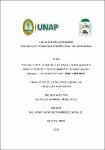Relaciones fenotípicas entre marcadores morfológicos y el rendimiento en maní (Arachis hipogea L.) Zungrococha - San Juan 2019
Abstract
La investigación se llevó a cabo en el taller de enseñanza e investigación hortícola correspondiente la Facultad de Agronomía de la UNAP. El nivel de investigación fue relacional. El objetivo principal fue generar información sobre las relaciones fenotípicas entre la altura de planta, el número de vainas /planta, ancho de vaina, largo de vaina y número de granos/vaina con el rendimiento de grano por planta. El diseño experimental fue bloques completos al azar, cinco repeticiones y cuatro tratamientos. Cada unidad experimental estuvo constituida por cuatro hileras, ocho plantas por hilera y la unidad de muestreo estuvo constituida por seis plantas/unidad experimental. El carácter altura de planta con el rendimiento de grano ha demostrado asociaciones positivas y significativas, pero no consistentes expresados en coeficientes de regresión positivos y negativos. El carácter número de vainas por planta, está asociado positivamente significativa y altamente significativa con el rendimiento, y expresados con valores de regresión positivos mostrando consistencia en todas las variedades de maní estudiados. El carácter ancho de vaina está asociado positivamente significativa y altamente significativa con el rendimiento para las variedades de maní estudiados pero inconsistente toda vez que mostró relaciones positivas y negativas, el cual se corrobora con los análisis de variancia de la regresión donde solo se demuestra dependencia estadística en la variedad de maní “morado”. El carácter largo de vaina está asociado positivamente y significativamente con el rendimiento para las variedades de maní estudiados pero inconsistente toda vez que mostró relaciones positivas y negativas, el cual se corrobora con los análisis de variancia de la regresión donde no se demuestra dependencia estadística en las cuatro variedades de maní. El carácter número de granos por vaina está asociado positivamente, significativa alta significancia estadística con el rendimiento de grano para las variedades de maní estudiados pero inconsistente toda vez que mostró relaciones positivas y negativas. Realizar trabajos de mejoramiento intrapoblacional con selección, para productividad en el cultivo del maní, tomando en cuenta principalmente como criterio de selección indirecta el número de vainas por planta en las condiciones de clima y suelo donde se trabajó. The research was carried out in the corresponding horticultural teaching and research workshop of the Faculty of Agronomy of the UNAP, located in the Zungarococha farmhouse, San Juan, Maynas, located south of the city of Iquitos. The level of research was relational. The main objective was to generate information on the phenotypic relationships between the height of the plant, the number of pods / plants, the width of the pod, the length of the pod and the number of grains / pods with the yield of grain per plant. The experimental design was randomized complete blocks, five repetitions and four treatments. Each experimental unit consisted of four rows, eight plants per row and the sampling unit consisted of six plants / experimental units. The plant height character with the grain yield has shown positive and significant but not consistent associations expressed in positive and negative regression coefficients. The character number of pods per plant, is positively significant and highly significant associated with yield, and expressed with positive regression values showing consistency in all peanut varieties studied. The wide pod character is positively significant and highly significant associated with the yield for the peanut varieties studied but inconsistent since it showed positive and negative relationships, which is corroborated with the regression variance analyzes where only statistical dependence is demonstrated. in the “purple” peanut variety. The long pod character is positively and significantly associated with the yield for the peanut varieties studied but inconsistent since it showed positive and negative relationships, which is corroborated with the analysis of variance of the regression where no statistical dependence is demonstrated in the four peanut varieties. The character number of grains per pod is positively associated, significant high statistical significance with the grain yield for the peanut varieties studied but inconsistent since it showed positive relationships and negative Perform intrapopulation improvement work with selection, for productivity in the cultivation of peanuts, taking into account mainly as an indirect selection criterion the number of pods per plant in the climate and soil conditions where it was worked.
Collections
- Tesis [671]
The following license files are associated with this item:


